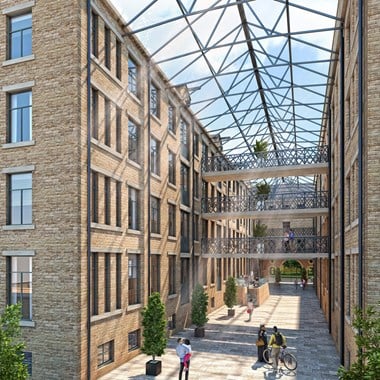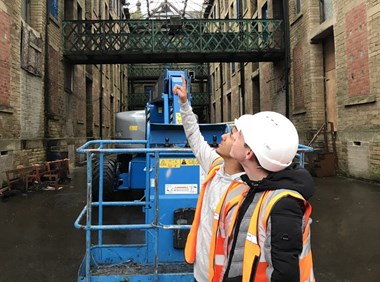Latest Success Stories
Regenerating Brierfield Mills: An MP’s eye-view
This Grade II listed cotton spinning mill is located in the Brierfield Mills Conservation Area, largely dating back to 1868.
The mill was purchased by Pendle Council in 2012 with funding from the Homes and Communities Agency.
A joint venture company between Pendle Council and local developer Barnfield Investment Properties was formed to deliver a £32 million redevelopment programme, transforming the area into a mixed-use development, including a new leisure facility run by Burnley FC in the community, the largest adult learning centre in Lancashire, the creation of a canal marina, 70 residential apartments and a creative arts studio for In-Situ, a Pendle based arts organisation.
Andrew Stephenson
MP
Andrew has represented the seat of Pendle in East Lancashire since 2010. He is Minister of State at the Department for Transport.
Over the last decade he has been heavily involved in the regeneration of the huge Brierfield Mills site on the banks of the Leeds Liverpool Canal, which closed as a textile manufacturing site just before he was first elected.
Why did you get involved in Brierfield Mills?
It’s an amazing piece of industrial heritage that played a crucial role in the growth of Nelson during the industrial revolution. Local people worked here in significant numbers until relatively recently and there is a sense of community pride ingrained in the place. Its importance reached across communities too, with a large number of workers emigrating from Pakistan to come and work in the mills. Sadly, it was also in an incredibly vulnerable state and it was a question of acting swiftly and decisively or perhaps losing it forever. I was also motivated by the evident opportunities for local people that would flow from the major regeneration project, what we’d now refer to as levelling-up.
How did you help to move the project forward?
Like other MPs, I do not have any formal powers or budgets for my constituency, but I was able to bring together local people, decision-makers and investors. Over the years I’ve toured the mills at various times with six different ministers, helping to secure the £1.5 million initial government funding to buy the site in 2012. This was the crucial first step which has unlocked much larger sums of private sector investment over subsequent years.
What were the greatest challenges you faced?
Scepticism and a lack of confidence that such an ambitious project could be realised in an area of significant deprivation, a place which has taken a lot of hits over recent years. Also concern that the project wouldn’t properly include local people. The original government funding alone took two years of lobbying and persuasion to put together, and we had to make a strong case to stakeholders within the Lancashire Enterprise Partnership, as well as within national government, that this project was worth backing.
What advice would you give to fellow MPs and communities who are trying to save and repurpose heritage in their areas?
Have a vision and be prepared to sell it relentlessly. Be persistent, never, ever give up even if the challenge of such a project is daunting at times. Nurture relationships with national and local government. Recognise the need for excellent commercial partners, and the importance of the third sector too to build a robust business case, ensuring long-term financial viability. Make local people a part of the plans from the outset as this is their heritage.
Conditioning House conversion brings New York-style living to central Bradford
Once an iconic building in Bradford’s bustling textile industry, the Grade II listed Conditioning House has been granted a new lease of life as a mixed-use development comprising 153 one, two and three-bedroom luxury apartments, plus a residents’ gym and office space.
Conditioning House was built in 1900-02 by the Bradford Corporation after a special Act of Parliament. The property was used to quality check and control the moisture content of textiles by means of laboratory examination and certify their true weight and length. It was the only property of its kind in England.
The site is actually made up of two buildings, separated by a full-height atrium. The buildings are only connected over the top three floors on the south side, creating a U-shaped building in plan.
The building was in use until the 1980s, but over the following 30 years it fell into an increasingly dilapidated state, suffering problems with fire, theft and water damage. However, seeing the potential of this unique building in the heart of central Bradford, developer, Priestley Homes, part of the Priestley Group, acquired Conditioning House in 2016.
Main contractor, Priestley Construction, has brought the building to life. It wasn’t possible to fully survey the building during the planning phase due to safety concerns, so the scheme has had to adapt and change throughout the development process. This has required the developer to work closely with Bradford City Council, and the development has been supported by a £1.5 million grant from the West Yorkshire Combined Authority Investment Committee.
Because of the size and nature of Conditioning House, the apartments are much bigger than the average city centre flat. Generous sizes range from 46 square metres to well over 100 square metres, with each of the penthouse apartments arranged over two floors.
Attention to detail and a desire to make the most of original features has been a key focus throughout. The six steel link bridges that connect the two buildings across the central atrium have been refurbished as unique balconies, providing external space for each of the 12 apartments that adjoin them.
Other retained features include crane wheels, fire bells and manufacturer’s plates – helping to keep the story of the building’s industrial past visible to residents. Efforts have also been made to salvage original roof tiles – with an incentive scheme to encourage the roofers to carefully remove and re-use the old tiles.
Conditioning House transformation
Please click on the gallery images to enlarge.
Interest in the apartments has been significant. Applications have come in from investors around the world; however, 40 of the apartments are earmarked for owner/occupiers, with the aim of creating a thriving neighbourhood in the heart of Bradford.
The scheme is due for completion in Q2 2021. You can find out more about the project on the Priestley Homes website.
Community leads mill regeneration in Castleford
Queen’s Mill in Castleford is one of the great examples of on-going mill regeneration in the north, with its community at its heart. Its reimagining has been led by volunteers, with visions of how it can serve the local and surrounding communities, now and in the future. Its origins stretch back to the 11th century, with the original mill established by Henry de Lacy, of nearby Pontefract Castle, by at least 1093. The building we see today dates mainly from two expansion and modernisation schemes carried out in 1862 and 1885, however there is surviving stonework dating from 1746–7 within the structure.
After a devastating fire in 1897 the mill stood silent and unused until 1921, when Thomas Allinson took up the lease. Allinson returned to the traditional way of milling by removing the steel rollers and reinstating the millstones. In true Yorkshire fashion, Queen’s Mill proudly produced the famous, “flour wi’ nowt taken out”. By the 1970s, with 20 pairs of stones producing up to 500 tons of flour per week the mill had the status of the biggest stoneground mill in the world.
This milling pedigree has come in handy recently by keeping its local community in flour during the Covid-19 pandemic. Two sets of millstones remain operational and small-scale wholemeal flour production continues. So unlike the streets, pubs and parks during lockdown, Queen’s Mill was far from silent; selling more flour in the first month of the pandemic than in the previous year and a half. Run by volunteers, they have been working to produce flour for the surrounding community when the supplies in shops dwindled.
The success of Queen’s Mill shows the versatile and surprising roles mills can take. Queen’s Mill delivered more than just flour during this time of crisis, it delivered hope to its community, and it doesn’t have to stand alone. How many more mills can we resurrect to serve the communities of the present, as they once served those of the past?
There are other exciting projects in the pipeline at Queen’s Mill, such as the renovation and reuse of its waterwheel. Although to this day, the mill is still embracing traditional milling techniques, in 1885, it was at the height of modernity by becoming the first building in the town with an electricity supply. To generate such a large amount of power a substantial waterwheel was needed, which is still in situ today. Measuring 21ft in diameter and 14ft wide the wheel remained in use until 1970.
There are plans underway to restore the waterwheel so it will, once again, produce electricity to power the mill. Although a sizable project, the regeneration of the waterwheel will be a valuable educational tool for local schools, community groups and general visitors, and a way to celebrate the local history of Castleford. Practically the waterwheel and its production of electricity will not only help transform the mill into a more environmentally sustainable building but also help generate some income for the mill by selling any excess power produced to the national grid.
The future of the mill hasn’t always been as certain as it is today. There were proposals either to convert the building into apartments or to demolish it. However, in 2013 Castleford Heritage Trust (CHT) bought the mill saving it from possible demolition, with a vision to transform it into a museum, education, exhibition and events venue for the town. Other than the initial stripping-out of redundant equipment and subsequent specialist work, the substantial task of converting Queen’s Mill has been carried out by a team of local volunteers; with most of the funding coming from a series of small grants for specific projects.
The mill now hosts a wide range of regular groups and community activities. These activities vary from one-off events and theatre performances to beer festivals. Income is generated by letting out space, at reasonable rates, including a popular local tea room and craft beer shop. The spaces hired out are done so to businesses and organisations that will benefit the community, including, citizens advice and youth employment services. The mill is now home to several statutory and voluntary organisations providing community services and in March 2020, Queen’s Mill became the Castleford hub for services provided by Wakefield District Council and volunteers; to aid vulnerable residents during the Covid-19 pandemic.
There is still plenty to do at Queen’s Mill, but the work done since 2013 demonstrates what can be achieved by the passion and determination of volunteers working toward a clear objective. In a town which has lost many of its industries and associated landmarks, Queen’s Mill offers both a reminder of its thriving past and a focus of ambition for its future.
Next phase of Hunslet Mill conversion now underway
The second phase of a £50 million scheme to convert listed mills for residential use at Victoria Riverside, Atkinson Street, Leeds is completely sold out, and work is already underway on the next phase.
The 350 unit scheme is being delivered by J M Construction, and is due for completion in 2023.
This 3.1 acre site includes a number of Grade II and Grade II* listed textile mills, making the complex the largest and last remaining large scale textile flax mill to survive in Leeds. The site has several ranges, the most notable of which is the seven-story warehouse range facing the River Aire. In the mid-1800s the mills employed 1500 largely female flax workers.
The area in which the mills stand formed part of the industrial heartland of Leeds, with the former medieval township of Hunslet evolving to become the focus of heavy industrial engineering, including the famous Hunslet Railway works.
However much of the area saw mass clearance schemes in the 1960s and 70s, which isolated the industrial areas and the town of Hunslet from the city centre of Leeds.
The mills were previously earmarked for demolition but the area is beginning to come to life again as new occupants move in thanks to the creativity and ambition of the developers. This scheme is entirely privately funded and will see all five listed mill buildings in the complex being converted into apartments.
The retention of historic features has been instrumental in the success of this project. The newer elements of the conversion have included lightweight roof penthouses and a new infill range to complete the corner at the top Goodman and Atkinson Streets. This approach and fusion of modern and traditional construction has proved popular, with all 160 units from the first two phases now sold.
The project has been an icon of regeneration for the south of the city and has provided much needed residential activity in the area. With other new developments underway nearby, the vision for an interesting and attractive walkable link from Hunslet to Leeds, with Hunslet Mill as its centre piece, is now almost complete.
Historic England and Leeds City Council have been collaborating for years to find ways to give a new purpose to these historical assets. The Yorkshire team at Historic England have enjoyed working with J M Construction on their ambitious project which will remove the Grade II* Hunslet Mill from Historic England’s Heritage at Risk Register.
-
Our Grant Schemes
Our grants are an essential part of our work to protect the nation's heritage.
-
Contact Our Local Offices
Find out how to get in touch with our national and regional offices.
-
Looking After Our Industrial Heritage
This section provides information for those who own, manage or are developing an industrial site or want to set up a building preservation trust.
-
Arson Risk Reduction
This guide is designed to help identify threats and take steps to make properties less of a target for arson.
-
Vacant Historic Buildings
An owner's guide to vacant historic buildings









